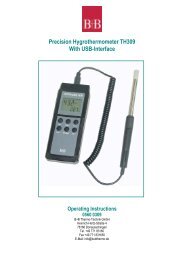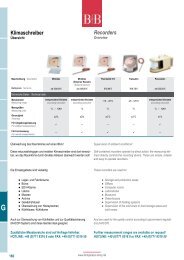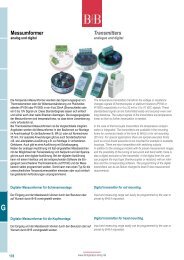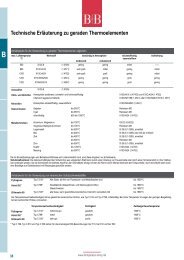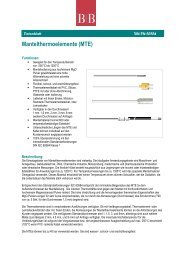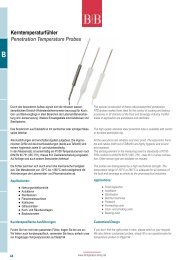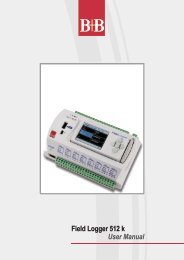B - Temperatur-Shop
B - Temperatur-Shop
B - Temperatur-Shop
You also want an ePaper? Increase the reach of your titles
YUMPU automatically turns print PDFs into web optimized ePapers that Google loves.
Thermal Detector<br />
Detector in which the photons of incident radiation are converted to heat and then<br />
into a signal from the detector. Thermal detectors include pyroelectric, bolometer, and<br />
thermopile types.<br />
Thermal Drift<br />
See temperature coefficient.<br />
Thermal Radiator<br />
An object that emits electromagnetic energy due to its temperature.<br />
Thermal Shock<br />
An error due to a rapid change in the ambient temperature of an instrument. Expressed<br />
as a maximum error and the time required for performance to return to prescribed<br />
specifications.<br />
Thermistor<br />
A semiconductor material whose resistivity changes with temperature.<br />
Thermocouple<br />
A set of two junctions of two dissimilar metals used to measure temperature by means of<br />
the Peltier effect, whereby heat is liberated or absorbed by the flow of electrical current<br />
through a junction of two dissimilar metals such that an electrical potential develops<br />
between two such junctions in proportion to the difference in temperature of the junctions.<br />
A variety of types exist including:<br />
J (Fe / constantan)<br />
K (chromel / alumel)<br />
T (Cu / constantan)<br />
E (chromel / constantan)<br />
R (Pt / Pt - 30 % Rh)<br />
S (Pt / Pt -10 % Rh)<br />
B (Pt - 6 % Rh / Pt - 30 % Rh)<br />
G (W / W - 26 % Re)<br />
C (W - 5 % Re / W - 26 % Re)<br />
D (W - 3 % Re / W - 25 % Re)<br />
Thermoelectric (TE) Cooling<br />
Cooling based on the Peltier effect. An electrical current is sent through two junctions of<br />
two dissimilar metals. One junction will grow hot while the other will grow cold. Heat from<br />
the hot junction is dissipated to the environment, and the cold from the other junction is<br />
used to cool.<br />
Thermogram<br />
A thermal photograph generated by scanning an object or scene.<br />
Thermopile<br />
A number of similar thermocouples connected in series, arranged so that alternate junctions<br />
are at the reference temperature and at the measured temperature, to increase the<br />
output for a given temperature difference between reference and measuring junctions.<br />
Time Constant<br />
The time it takes for a sensing element to respond to 63.2 % of a step change at the<br />
target.<br />
Transfer Standard<br />
A precision radiometric measurement instrument with NIST traceable calibration in the<br />
USA (with other recognized standards available for international customers), used to<br />
calibrate radiation reference sources.<br />
218<br />
www.temperatur-shop.de<br />
Transmittance<br />
The ratio of IR radiant energy incident on an object to that exiting the object.<br />
Triple Point<br />
The condition of temperature and pressure under which the gaseous, liquid, and solid<br />
phases of a substance can exist in equilibrium. For water at atmospheric pressure, this<br />
is typically referred to as its freezing point.<br />
Two-Color Thermometry<br />
A technique that measures the energy in two different wavelength bands (colors) in order<br />
to determine temperature. The 2 color technique has been shown to be effective for correcting<br />
errors due to partial blockage of the target caused by dust particles.<br />
V<br />
Valley Hold<br />
Output of the minimum temperature measurement indicated by an instrument during the<br />
time duration for which this display mode has been active.<br />
Verification<br />
Confirmation of a design with regard to performance within all prescribed specifications.<br />
Vibration Test<br />
A test where oscillatory or repetitive motion is induced in an object (as per MIL-STD-810<br />
or IEC 68-2-6), which is specified as an acceleration in g?s and power spectral density<br />
(PSD), after which the unit is tested for proper operation.<br />
W<br />
Warm-Up Time Absolute Zero<br />
The temperature of -273.15 °C, -459.69 °F, or 0 K; thought to be the temperature at<br />
which molecular motion vanishes and a body would have no heat energy.<br />
Wet bulb temperature<br />
The wet bulb temperature Tw, is the temperature of the moistenrd thermometer during<br />
measurement of relative air humidity with the Aspirations-Psychrometer. A thermometer<br />
covered with a moistened wool wick is exposed to a constant airflow. After some time,<br />
temperature equilibrium is reached. Together with ambient temperature and total<br />
pressure, the relative humidity can also be calculated from the wet bulb temperature






